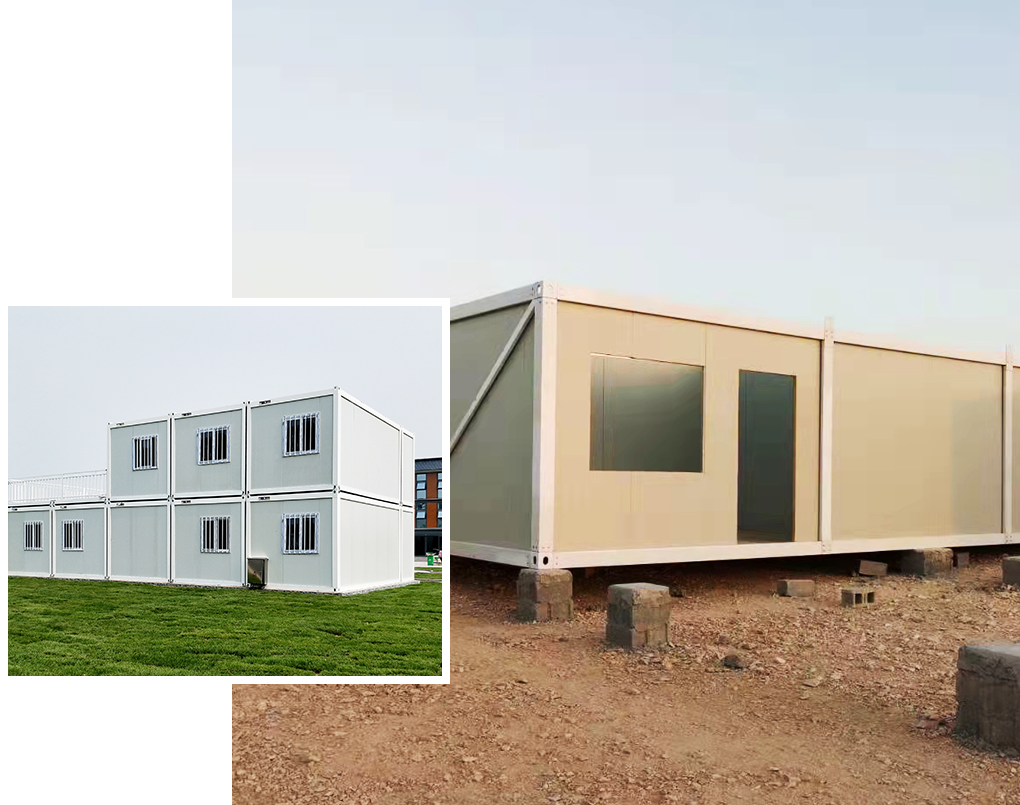Why Are Flat Pack Container Houses More Favored Than Mobile Homes?
In the field of temporary buildings, flat pack container houses are increasingly gaining favor and capturing more market share. The former leader in this field of temporary construction—portable houses—has seen its dominance challenged. Is this really true? Today, let's explore several aspects to see how container houses have "defeated" portable houses.
Flat Pack Container House vs. Portable House: Structural Comparison
The flat pack container house is of welded construction, utilizing galvanized steel for the structure. It consists of a structural system, ground system, floor system, wall system, and roof system. Each system is composed of multiple unit modules completed in the factory, and the house is assembled on-site from these modules. They are stylish, unique, quick to install, easy to move and transport, simple to dismantle and store, and eco-friendly.
Portable houses use lightweight steel as the framework and sandwich panels as the enclosing material. They have low resistance and are prone to collapse if the foundation is unstable or during events like typhoons or earthquakes.
Flat Pack Container House vs. Portable House: Design Comparison
Flat pack container houses incorporate modern design elements and offer customization services based on product types and customer needs. They can be stacked vertically, extended horizontally, and freely assembled to create spacious and personalized living spaces. The adjustable base of the house can also adapt to different ground conditions.
Portable houses are designed with steel, panels, and other materials as the basic components for on-site installation, offering poor performance in sealing, soundproofing, fire resistance, moisture protection, and insulation.
Flat Pack Container House vs. Portable House: Performance Comparison
Flat pack container houses are earthquake-resistant up to Level 8, wind-resistant up to Level 11, with a lifespan of over 20 years. They are also eco-friendly and reusable.
Portable houses are earthquake-resistant up to Level 7, wind-resistant up to Level 9, with a lifespan of 8 years and can be disassembled and reassembled 2-3 times.
Flat Pack Container House vs. Portable House: Foundation Comparison
Flat pack container houses require simpler foundations—either strip or pier foundations—or can even be placed directly on the ground without any foundations, eliminating the need for leveling the indoor floor.
Portable houses require more complex foundation treatments, including pouring concrete foundations, which cannot be reused.
Flat Pack Container House vs. Portable House: Installation Comparison
This kind of prefab container house for sale is quick to install, with short construction periods. Four workers can complete the installation of a single container in half a day. They can also be transported as whole units, usable immediately upon connecting water and electricity on-site.
Portable houses require pouring concrete foundations, assembling the main structure, installing color steel plates, hanging ceilings, and installing water and electric systems. The installation period is 20-30 days and involves high-risk manual labor.
Flat Pack Container House vs. Portable House: Transportation Comparison
Flat pack container houses can be transported in flat-packed or whole unit forms using multiple transportation methods, significantly reducing long-distance transport costs.
Disassembled portable houses contain a large number of scattered materials, making transportation more cumbersome.
Flat Pack Container House vs. Portable House: Application Field Comparison
Flat pack container houses are suitable for camps, commercial use, military use, tourism, and more, often serving as offices, exhibition halls, sales offices, inns, supermarkets, apartments, etc., enhancing living comfort and fulfilling both living and recreational needs.
Portable houses are mainly used on temporary construction sites.
Flat Pack Container House vs. Portable House: Energy Conservation and Environmental Protection Comparison
Flat pack container houses adopt a "factory-prefabrication + on-site installation" model, generating no construction waste on-site. After project dismantling, no construction waste remains, preserving the local environment. Additionally, flat pack container houses are reusable with zero transitional waste, reducing environmental pressure.
On-site installation of portable houses damages the local environment and generates substantial transitional construction waste with low reuse rates.
The greatest feature of flat pack container houses is their specialized and personalized design, fully meeting people's residential needs in terms of insulation, heat resistance, soundproofing, etc. What's more, flat pack container houses are not only professional but also standardized, modular, and universal. Integrated houses can be used for living or storage, with options tailored to the nature of stored goods. For instance, items susceptible to moisture can be stored in walls with higher heat resistance to prevent internal air convection from generating moisture.
Flat pack container houses can serve as offices, living quarters, restaurants, bathrooms, and large combined spaces, meeting the needs of construction site camps, field operation camps, municipal resettlement housing, and various commercial housing needs. They are widely used in regions such as China, Europe, Japan, the Middle East, Southeast Asia, and Africa.
As a professional flat pack container house factory, Hebei Zhongtai Steel Structure Technology Co., Ltd. is a leading modular construction comprehensive service provider in China. The company specializes in container buildings and steel structure modular houses (such as flat pack container houses), enhancing products through design to create prefabricated, high-turnover, and reusable modular buildings. Committed to providing one-stop brand services and integrated solutions from planning, design, manufacturing, to construction, the company is a trustworthy and optimal choice for clients seeking integrated solutions in modular construction.
 English
English  français
français  Deutsch
Deutsch  Español
Español  русский
русский  العربية
العربية  tiếng việt
tiếng việt  Indonesia
Indonesia  Latinae
Latinae 



